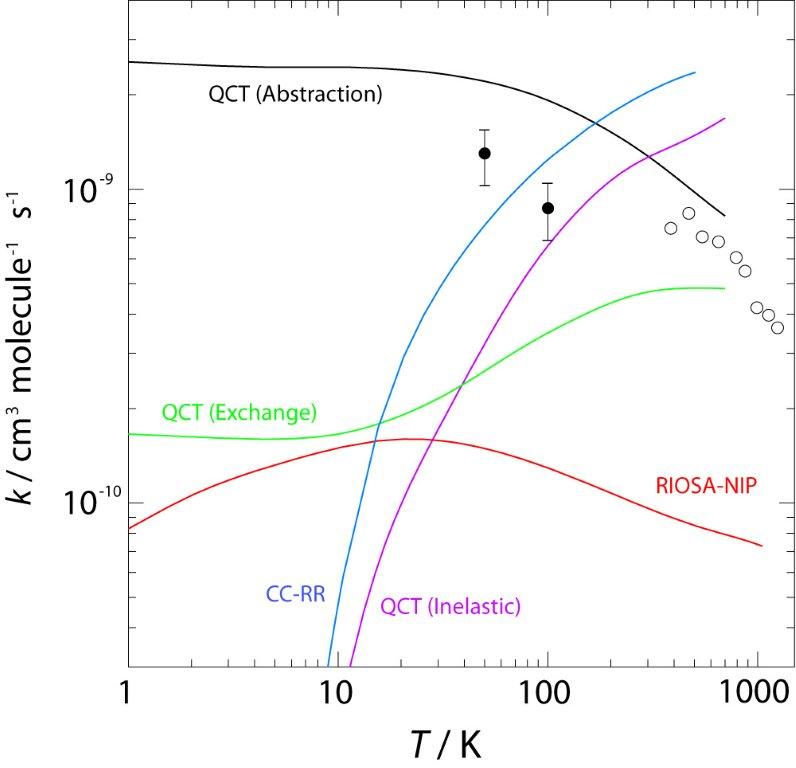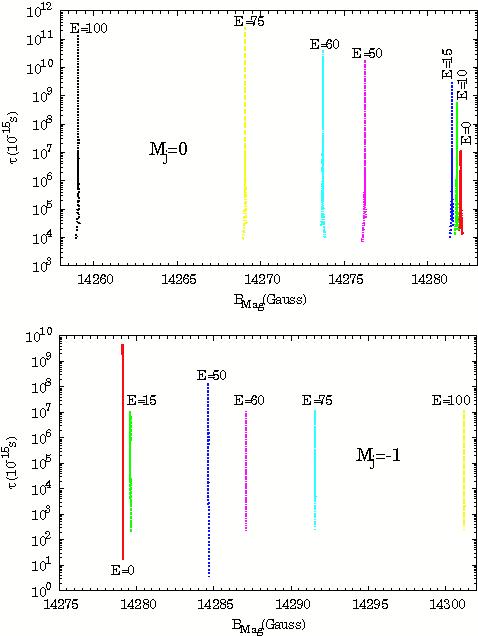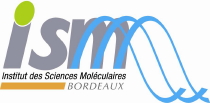Cold and Ultra cold collisions in the gas phase
T. Stoecklin, P. Halvick.
Recent PHD's: Grégoire
Guillon (2006-2009); Florence Turpin (2008-2011)
Open Phd position: see our offer
1. Interstellar Chemistry
Astrochemistry is a fast expanding field which benefited greatly from the progresses
done in the recent years in the measurements of the rotational spectra of the
molecules of the dense and diffuse interstellar clouds. These progresses were
also made possible by the collaborative work performed with the national
program of CNRS Physicochimie du Milieu Interstellaire
and with the three successive European Networks to which we participated and
were dedicated to this subject. The major question raised by the astronomers measurements is to evaluate the corresponding
molecular abundances of the detected species. With typical densities of
astrophysical environments, the strengths of collisional
and radiative transitions are often comparable,
resulting in non-Local thermodynamic equilibrium molecular level excitation.
Then, the level populations have to be calculated by explicitly taking into
account the different processes that regulate them, and for this, the collisional coefficients have to be known.
Figure 1. Comparison of the QCT rate coefficients for abstraction and
exchange reaction with the RIOSA-NIP reaction rate coefficient, along with
experimental results (open and solid circles) for abstraction reaction.

In most
environments, inelastic collisions with helium and molecular hydrogen are
dominant, but in some conditions (in the presence of ionizing UV or X ray photons) collisions with electrons can become
important, particularly for ions. We continuously develop our own Close
Coupling inelastic scattering code and adapt it to the open shell structure of
the collision partners. The systems we treat and the corresponding potential
energy surfaces models and scattering codes we develop are for collisions
between atom and diatom; diatom and diatom as well as for electron and linear
molecules. Collisional excitation rate coefficients which are calculated are
made available for the astronomers on the BASECOL database (http://basecol.obspm.fr/) which is developed in
collaboration with Marie Lise Dubernet
in Meudon. The detailed knowledge of the reactive
processes between C or H and simple molecules are also needed and we recently
developed a new time independent quantum approach based on the use of Negative
Imaginary Potential(NIP). We also compare our reactive
results with those obtained with our home made quasi-classical trajectory code.
We give an example of such comparison for the reactive collisions H + CH+
which we treated recently in Figure 1.
Recent
Publications in this field
* Electron-impact
rotational and hyperfine exciatation of HCN, HNC,
DCN, and DNC. A. Faure, H. N. Varambhia, T. Stoecklin and J. Tennyson, Mon. Not. R. Astron. Soc. (2007)
382: 840
*
Differential cross
sections and product energy distributions for the C(3P)+OH(X2P)
→ CO(X1S+)+H(2S) reaction using a quasiclassical
trajectory method. A. Zanchet, Ph. Halvick, B. Bussery-Honvault and P. Honvault,
J. Chem. Phys. 128, 204301 (2008).
* Correlation-polarisation effects in electron/positron scattering from
acetylene: a comparison of computational models. J. Franz, F. A. Gianturco, K. L. Baluja, J.
Tennyson, R. R. Lucchese, T. L. Gibson, T. Stoecklin, Nucl.Instr..Meth. B (2008) 266:
425
* A comparative multi-property
analysis of existing models for the He-N2 potential energy surface.
T. Stoecklin, A. Voronin,
A. K. Dham, J. Sanchez-Fortun
Stoker and F. R. W. McCourt, Mol. Phys. (2008) 106: 75
* Three
dimensional atom-diatom quantum reactive scattering calculations using
absorbing potential: Speed up of the propagation scheme. T. Stoecklin,
Phys. Chem. Chem. Phys. (2008) 10:
5045
* Rotational
relaxation of HF by collision with ortho and para-H2
molecules. G. Guillon, T. Stoecklin, A. Voronin et P; Halvick, J. Chem.
Phys. (2008) 129: 094397
* Scattering of electrons
by gaseous CS(1S) The role of short-range forces on the near-threshold
2P resonance
F. Sebastianelli, F.A. Gianturco; T.
Stoecklin; I. Baccarelli,
Chem. Phys. Lett.(2009) 476: 182
* Non-threshold, threshold, and nonadiabatic behavior of the key interstellar C+C2H2
reaction. M. Costes,
Ph. Halvick, K. M. Hickson,
N. Daugey, C. Naulin, Astrophys.
J. 703, 1179 (2009).
* O+OH
→ O2+H: A key reaction for interstellar chemistry. New theoretical results and comparison with experiment. F. Lique, M. Jorfi, P. Honvault, P. Halvick, S. Y. Lin,
H. Guo, D. Q. Xie, P. J. Dagdigian, J. Klos, M. H.
Alexander, J. Chem.
Phys. 131, 221104 (2009)
* On the statistical behavior of the
O+OH → H+O2 reaction: a comparison between quasi-classical
trajectory, quantum scattering and statistical calculations. M. Jorfi, P. Honvault, P. Bargueno, T. Gonzalez-Lezana, P. Larrégaray,
L. Bonnet and Ph. Halvick, J. Chem. Phys. 130, 184301 (2009).
* The ionic
pathways of lithium chemistry in the early universe: Quantum calculations for LiH+ reacting with H. S. Bovino,
T. Stoecklin and F. A. Gianturco,
ApJ (2010) 708:
1560
* Rotational excitation and de-excitation of CH+ molecules by 4He atoms. F. Turpin, T. Stoecklin1 and A. Voronin, A&A 511, A28 (2010)
* Rate
constant for the C(3P)+ OH(X2P) → CO(X1S+) + H(2S) reaction using various
dynamical methods and potentials. Mohamed Jorfi,
Béatrice Bussery-Honvault,
and Pascal Honvault, Thierry Stoecklin
and Pascal Larregaray, J. Phys. Chem. A, 114: 7494 (2010)
* Is H+ an
efficient destroyer of LiH molecules? A quantum investigation at the Early Universe conditions. S.
Bovino, M. Tacconi, and F.
A. Gianturco, T. Stoecklin
(ApJ (2010) in press)
2. Cold and ultracold
chemistry
Recent experimental
advances have made possible to cool gas-phase molecules to temperatures far
below 1 K and trap them in well-defined internal states. Translational
temperatures in the Microkelvin range have been
achieved for molecules in optical traps, and even quantum degenerate gases of
weakly bound molecules have been experimentally realized. These novel
capabilities open the way to new technologies based on quantum control of
molecular processes at very low temperatures and provide us with new ways to
explore the fundamental principles that govern cold collisions. Ultracold molecules are considered for applications like
implementation of qubits for scalable quantum
information devices; tests of fundamental symmetries, or entanglement tests.
Figure 2: Highest positive Close Coupling Q matrix eigenvalues
as a function of the magnetic field for the collision of 3He
with respectively NH( a=1) and MJ=MT=-1
on the lower panel and NH( a=2) and MJ=MT=0 on the higher panel. The value
of the applied electric field is indicated on each curve and is given in
kV/cm.

Instead of
being driven by thermal processes, ultracold
collisions are governed by quantum dynamics involving tunneling or scattering
resonances and the long range potential at work may be strongly modified by
applying combinations of moderate electric and magnetic fields. The theoretical
studies which we perform are mainly concerned with the buffer gas cooling and
the magnetic trapping techniques. We are currently developping
codes allowing to theoretically study the best molecular candidates to be
cooled and trapped using these techniques. We for example treated the case of
atom + S molecule
collisions submitted to a combination of electric and magnetic fields. An
example of application to the 3He + NH(3S) collisions is given in Figure 2
where the lifetime of a magnetically tuned zero energy Feshbach resonances is
studied as a function of the magnitude of a superimposed parallel electric
field. .
Recent
Publications in this field
* Effect
of spin-rotation interaction in cold and ultra cold collision of N2+(2S+)
with 3He and 4He. G. Guillon,
T. Stoecklin and A. Voronin,
Phys. Rev. A. (2007), 75:052722
* Zeeman relaxation of
N2+ (2Σ+) in collisions with 3He
and 4He. G. Guillon, T. Stoecklin and A. Voronin, Eur. Phys. J. D.
(2008) 46: 83
*Vibrational and rotational energy transfer of CH+
in collisions with 4He and 3He. T Stoecklin
and A. Voroni, Eur. Phys. J. D. (2008) 46: 259
* Spin depolarisation
of N2+ (2Σ+) in collisions with 3He
and 4He in a magnetic field. G. Guillon,
T. Stoecklin and A. Voronin,
Phys. Rev. A. (2008) 77: 042718
* Exact,
Born-Oppenheimer, and quantum chemistry-like calculations in Helium clusters
doped with light molecules: The He-N2 system. O. Roncero,
M. P. de Lara-Castells, G. Delgado-Barrio, P.
Villarreal, T. Stoecklin, A. Voronin
and J. C. Rayez, J. Chem. Phys., (2008) 128: 164313
* Analytical
calculation of the Smith lifetime Q matrix using a Magnus propagator:
Applications to the study of resonances occurring in ultra cold inelastic
collisions with and without an applied magnetic field. G. Guillon
and T. Stoecklin J. Chem. Phys. (2009) 130: 144306
* Combining electric and magnetic static field for the
tuning of the lifetime of zero energy Feshbach resonances: Application to 3He+NH(3S) collisions
T. Stoecklin,
Phys. Rev. A. (2009) 80: 012710
* Spin depolarisation
of N2+ (2Σ+)
in collisions with 3He
in a magnetic field: general behaviour and zero energy
Feshbach resonances
G. Guillon,
T. Stoecklin and A. Voronin, Phys. Scr. (2009) 80: 048118
* A comment about the tuning of the lifetime of
zero energy Feshach resonances using parallel
electric and magnetic fields. T. Stoecklin, Faraday Discussion (2009) 142: 226
* The
interaction of MnH(X7S) with He: Ab initio potential energy surface
and bound states. Florence Turpin, Philippe Halvick
and Thierry Stoecklin, J. Chem. Phys. 132: 214305 (2010)
* Collisional
Zeeman relaxation of MnH (X7Σ+):
mechanism and comparison with experiment. F. Turpin, T. Stoecklin and Ph. Halvick,
(submitted)


